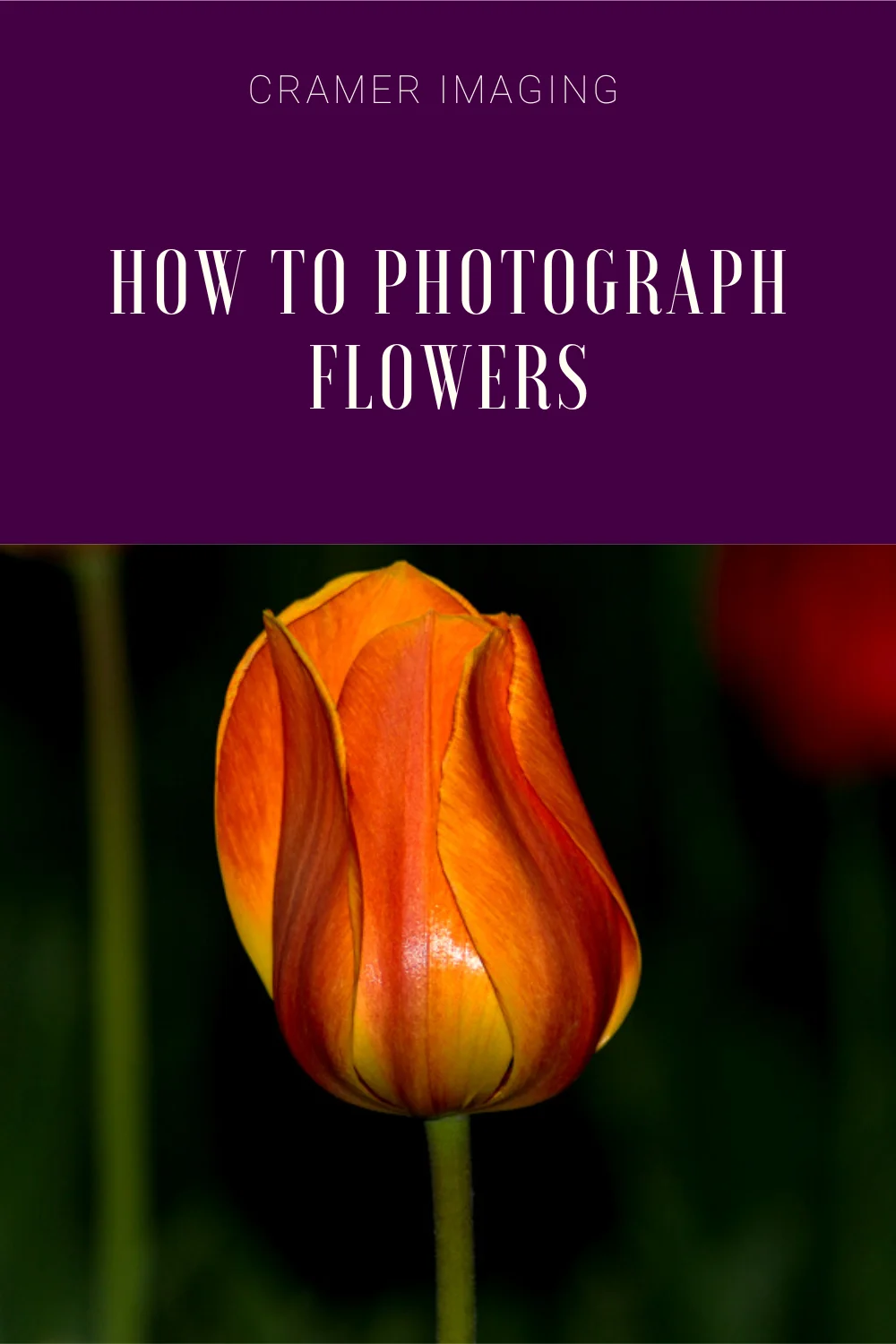How to Photograph Flowers
Shop

People love flowers and love taking pictures of them. Some of the pictures people take are good and some are not so good. How do you make sure that your photos are something to be admired? Here are a few tips to photograph flowers.

Use Basic Composition Techniques
When taking photos of anything, including flowers, remember your basic photo composition techniques. Just because it’s a pretty and colorful flower does not excuse you from using proper technique.
Some basic composition techniques are as follows:

Simplicity
As you can see, the simplicity technique is a complete focus on the subject with no distracting elements. The subject need not fill the frame or even be centered in the frame.

Rule of Thirds
The rule of thirds divides the frame into nine even boxes forming a grid pattern. The major weight of the image happens along those dividing lines. The rule of thirds specifically avoids centering the subject in the frame.

Golden Mean
The golden mean is a composition technique where you imitate the snail shell spiral in your area of focus and your subject matter. It can be difficult for a beginner to master.
Check out more basic photography composition techniques by reading this article.
Flowers are just like any other photo subject. They shine the best when proper composition techniques are used. Remember that you can also stack techniques together and give your flowers maximum impact.

Photograph Flowers in the Shade
We all love the even color tones of flower petals in pictures. There is something about that uniformity which really draws our eyes. Sadly, this uniformity of color cannot be achieved in direct sunlight. You must seek out shade in order to photograph flowers and get the subtlety of the lighter and darker palette each flower displays.


One of the serious downsides to direct sunlight is that of bright and distracting parts of the photograph which draw your eyes away from the subject matter. Shade evens out the lighting for the subject, the foreground, and the background at the same time.

All flowers spend some time in the shade so you must seek out that time in order to get the best flower pictures. Your alternative is to build or create the shade yourself. I have constructed shade and used my own shadow to block the direct sunlight from my flower subjects before.

No matter how you shade your flower subjects, you will get the most pleasing results from indirect sunlight. Take advantage of morning and evening shade. This is soft diffuse light and large structures cast long shadows you can use.
Use A Tripod to Photograph Flowers

I often find that I really need a tripod when I’m taking photos of flowers. I can’t seem to hold the same position for very long and several of the images end up being blurry. Sometimes the blurry photos are the pictures with the best composition. What a loss and waste of time when that happens.
Then I also find a problem with the wind. The slightest breeze can and will blur an otherwise beautiful flower photograph really fast. Idaho is a very windy place especially during the spring. Good flower photographs can be difficult just because of this weather fact.
I find that the tripod helps counter some of the effects of wind blur on the camera end. When used in combination with a windbreak, I can get beautiful flower photos even in bad conditions.
The tripod also ensures that I will have the exact same composition every shot I take so I don’t have to worry about my sharp photos being poorly composed. It means I get it right the first time with the light that I want instead of hoping that a retake will work out.
Photograph Flowers Before They Close For The Night
This may seem like common sense to a beginner photographer, but once you get into the craft, you may forget some of these tips. You cannot shoot an open flower photograph at dawn or dusk because they are closed. You can try for the bud style photos all you want to but a glorious open flower will forever elude you during those windows.

So, I spent several evenings last summer trying to get a beautiful photograph of some of the wildflowers growing along a ditch bank. I wanted that soft and diffuse light of evening and sunset for good reason. The problem is that all the flowers had closed. I couldn’t get the shot I wanted because of that simple fact.
Make sure to time your flower photography work when you know the blossoms will be open if that is the shot you are going for.
Isolate Your Close Subjects From the Background with Bokeh

There is something which really makes close-up flower shots amazing. This is the fact that they have been separated from the background with a natural blur that is known as bokeh.
Bokeh is what happens when you use a low aperture number on your camera. It is the natural blurring of anything which is not in focus or the shallow plane that you have chosen to focus on.
It is really a simple trick to use but you must make sure that you have focused on the correct area of the flower subject or else it won’t work. Our eyes are naturally drawn to the center of the flower so that area must be in focus if it is visible. This point is crucial if you want to photograph flowers.
If you need to, get the flower into proper focus and then recompose the shot with your shutter button halfway down. This will leave the camera focused where you want it and allow you to nail your composition.
Any composition technique, including those listed above, will work but the focus must be perfect for this kind of flower photograph to work. Do what you must to make your flower photos sharp if you want to contrast the flowers with bokeh.
Give Wide Angle Shots A Deep Depth Of Field
Not every amazing flower photograph is a close-up or a macro shot. Some of the most beautiful flower photos are wide angles. These kinds of photos require a different camera technique in order to work.

When attempting to take a wide angle shot of flowers, such as a field or a flowering tree, bokeh is not your friend. You must pursue a deep depth of field where as much of the background is in focus as you can get.

The camera technique requires a large aperture number to achieve that deep depth of field which really makes wide angle and landscape style photographs. You might also run into the term: “stop it down.” It’s the same thing.
Sometimes you might need your tripod when going for a shot like this. The large aperture number means a tiny hole for the light to enter the sensor so it may take longer for a proper exposure in lower light circumstances. Your tripod will eliminate hand motion blur for longer exposure times.
If you are wanting to go for something in between the close-up and the wide angle, then you still use the technique listed here. Clusters of flowers and flower beds still require a much deeper depth of field for proper focus than the close-up and macro shots require.
Try For Something Different
I’ve shown you lots of different but rather traditional photographs of flowers here. You can take lots of these kinds of flowers and be satisfied with them. There’s absolutely nothing wrong with that.

However, if you feel like being more adventurous, try for something different when you pull out your camera. Try a less traditional angle. Shoot from below. Shoot the inside of a flower we don’t see everyday. Come up with something all your own.

Adventurous photographs are the ones who receive notice and redefine the genre if the photographers do well. Make sure that you use good composition and proper lighting while being different.
Use A Spray Bottle For That Extra Something
Have you ever noticed that some of the most striking and beautiful flower photographs out there are pictures of wet flowers? For some reason, we really like flowers like that. The appearance of a fresh rain or dew adds something amazing to an average flower photograph.

Now, I don’t have the time or the patience to sit around and wait for a rain storm or check that there was dew in the morning. I must make photos when I can. So I must simulate the look of rain drops rather than use the real thing most of the time. I choose to use a simple spray bottle set on mist.
With my spray bottle, I can have the look I want when I want it in my flower photography. I get something special for practically no extra effort.
Conclusion
Photographing flowers is really a simple matter of composition, tools, technique, and timing. When you properly mix all of the above, you will greatly enhance your chances of taking a beautiful and amazing flower photograph. No matter what warm season of the year, take some time to smell and photograph the flowers.
Best Sellers
Cramer Imaging Newsletter

Receive monthly updates in your inbox from us.






